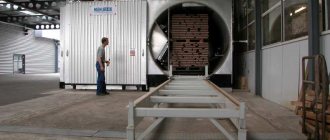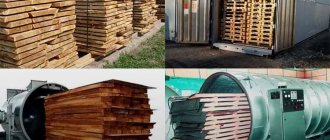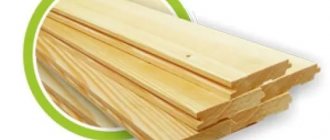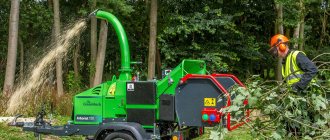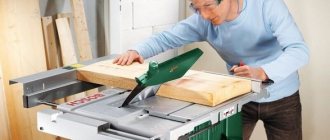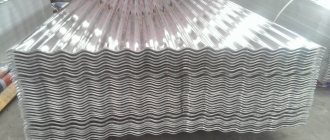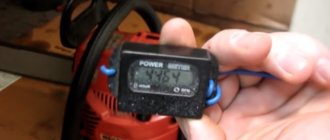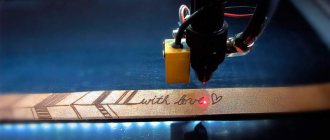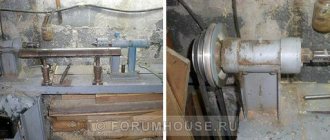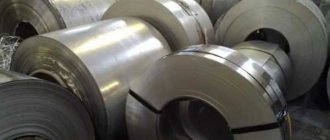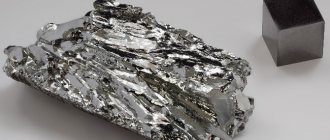Drying lumber and wood blanks has always been and remains the most important technological operation in the production of wood products. The process of reducing wood moisture content using an industrial method should be considered the main one - for several reasons. Firstly, because it is still manageable, and, secondly, it is much shorter than natural drying.
Controlling the drying process involves monitoring and regulating the evaporation of moisture from the surface of the wood. The intensity of evaporation is maintained by the temperature and humidity of the drying chamber environment.
By and large, a drying chamber is a complex of technological equipment designed specifically to remove excess moisture using thermal heating. The most important criterion for drying is reducing the amount of moisture while maximizing the preservation of the technological properties of wood.
"A C"
The current state of drying equipment at Russian enterprises can only be described as satisfactory. Sawmills and woodworking industries that have been operating for a long time use a large number of drying chambers of old designs that require significant modernization. And in some cases, cameras are only listed on the balance sheet, but do not work.
In order to properly dry lumber in such conditions, production workers spend enormous amounts of energy and labor. It turns out to be a kind of vicious circle. It is not possible to invest in the re-equipment of drying equipment due to the lack of necessary financial resources. As a result, the company does not have enough resources for effective growth.
Disadvantages of technology
The main criticism of this drying technology comes down to the risk of the formation of numerous defects in lumber during the operation. One of the most common of these is warping. Violation of technology can provoke both longitudinal and transverse deformations.
Typically, such processes are the result of insufficient moisture removal before the main drying stage. Often the material develops defects in the form of cracking at the ends. Similar defects arise if the lumber dryer operated in the configured mode during the initial warm-up stage. The technology requires that this process, even at minimum temperatures, be carried out under conditions of softening the structure of the lumber.
Is modernization needed?
It is irrational to start re-equipment with the purchase of equipment. Old drying chambers built from bricks, blocks, panels and other building materials, as a rule, require major repairs of enclosing structures (walls, ceilings, doors). If this is not done, then further re-equipment will be a waste of money. Significant heat losses will again lead to increased energy consumption, and therefore will not reduce the cost of drying lumber. There is only one way out - to do repairs or reconstruction (depending on the condition).
The old fashioned way
Previously, sawmills and woodworking enterprises built dryers with high productivity, which were used mainly for drying lumber to transport moisture. These are continuous chambers (for example, TsNIIMOD-49, TsNIIMOD-32, TsNIIMOD-24, NB, models with zigzag circulation, SP-5KM, etc.).
If in such chambers, inherited from Soviet times, in accordance with modern requirements, they try to dry lumber to an operating humidity of 8-10%, then it will not be possible to achieve a good result. There will be a large percentage of defects, the wood will dry unevenly. You should not expect high-quality drying of lumber in chambers of outdated designs, which implement outdated technology (ejection, gas chambers).
Homemade
Some manufacturers of wood products do not pay enough attention to drying production, mistakenly believing that they can create a drying chamber with their own specialists, not caring at all about the fact that they do not have knowledge of the process technology and design of such equipment. Because of this, in such home-made drying kilns, problems arise in practice related to obtaining high-quality lumber.
When building it yourself, they are usually guided either by the experience of a neighbor who has built a similar one, or by information from advertising brochures of drying chamber manufacturers, and often simply by relying on their own experience. This is mainly done by small woodworking enterprises with relatively low needs for dry lumber.
In the homemade version, the dryer is a closed heated room (usually with smooth or finned heating pipes placed on the walls) with a door for loading lumber. Exhaust air ducts are provided to release moist air. Often there is not only an automation system for controlling parameters, but also simple measuring instruments for visual monitoring of temperature and humidity of the environment. At the same time, the drying process is carried out almost uncontrollably, with the absence of any technology and modes.
At the first glance at such a “drying chamber,” one immediately notices the clearly insufficient circulation, unorganized movement of the drying agent in the chamber, lack of heat supply, and improperly organized supply and exhaust ventilation with the environment.
Lumber in such conditions turns out to be of poor quality. There is great unevenness of drying, a large number of defects - cracks, warping of assortments. In addition, the duration of the drying process in them is excessively extended. The material constantly has to be reloaded and sent back to dry.
Naturally, with a reasonable approach, you can build a drying chamber yourself, but still, in order not to make a large number of miscalculations in the design, it is better to contact specialized organizations, specialists in wood drying.
Main stage
After the initial warm-up, drying immediately follows. But the transition must be gradual, which is reflected in the slow opening of the air exchange dampers that remove moisture. At the same interval, the optimal parameters of heat flows are established. The temperature regime, in turn, is regulated by the opening level of the chamber blinds. If it is necessary to increase the saturation of the agent, the inlet pipes are completely closed.
Also, the degree of saturation of the thermal effect can be adjusted by starting the steam generator. However, steam injection systems cannot be connected when the hood is open. During the operation, chamber drying of wood is controlled by temperature characteristics and its error. In production, information about these values is usually entered into a log every hour.
A Question of Choice
Of course, the current state of lumber drying in Russia is not determined solely by the above. When organizing new productions, as well as when modernizing existing ones for the production of competitive high-quality wood products, they try to equip the production with modern equipment, including modern drying chambers. And it is right. However, here it should be noted that when investing in new production, entrepreneurs put the choice of a drying chamber in last place. Caring about technology and purchasing woodworking machines, for some reason they believe that choosing the necessary drying chamber will not be difficult. But this only seems to be a simple matter. There are many nuances that need to be taken into account.
How to properly dry wood so that cracks do not appear in it?
Proper wood drying processes are the key to obtaining high-quality material, without the formation of various cracks and other deformations of the wood.
The arrows indicate the process of evaporation of excess moisture from wood
Drying wood under the influence of atmospheric air assumes the presence of exposure to weather conditions, therefore a change in appearance may occur under the influence of strong sun or rain.
Ventilated wood should be placed under awnings. The drying process should be organized immediately after sawing the wood. It is necessary to correctly position the stacks of wood, create a gap between the stack and the ground surface of at least five hundred millimeters, using a variety of pads for this.
Air channels should be installed between rows in stacks for a more uniform drying process. In order to prevent cracking processes, the ends of the wood should be treated with drying oil or any type of oil paint.
Automatic drying processes are simpler in this sense, since the necessary data is already built into the programs.
In automatic dryers, a necessary condition for avoiding the deformation process is strict adherence to wood drying technology.
You need to know the nuances
Recently, a trend has developed in the forestry industry that investors are investing in production that brings profit in the short term. Because of this, recently they have been trying to build drying chambers in the form of easily and quickly erected insulated metal structures. But here too the question of choice arises. When considering various types of construction (convective, condensation, aerodynamic, vacuum), as a rule, they focus on cost.
Some manufacturers of drying chambers, in an effort to sell their product, do not particularly educate the client, praising their chamber.
Entrepreneurs often order a chamber with a large loading capacity (60-100 m3), mistakenly believing that they will be able to load all the material into it at the same time, including different thicknesses, and in the future it turns out that, having a large chamber, they underload it and violate the technological process.
Type of heating
Today, a fairly common phenomenon is the desire of most owners of drying kilns and those who are just planning to purchase one to establish heat supply from a hot water boiler that runs on sawmill and woodworking waste. At the same time, many have little idea about the required amount of waste and consider this option to be the cheapest. Maybe in the case of high-power boiler houses of 1-2 MW or more, this is true. Moreover, such boilers are also considered as a wood waste recycler at their enterprise.
In fact, when organizing a small boiler room for autonomous heat supply to the drying chamber, it is more economical to use electric heating or water heating boilers running on gas, diesel fuel and coal. The automatic burner of gas boilers does not require the presence of an operator. In regions with low electricity costs, electric boiler systems are naturally common. Automation of the drying and heat supply process affects the cost reduction, therefore, in the end, it turns out cheaper, or at least is at the level of heating the chamber with woodworking waste.
Pros of technology
Chambers with temperature and humidity treatment allow drying processes to be carried out while fully preserving the environmental friendliness of the material. In most cases, such processing methods do not require the use of active chemicals that increase the efficiency of the process. The high quality of the result is also noted. If the operator did not make mistakes when organizing the process, the resulting timber will acquire high strength and protective qualities.
Many people also point to the high productivity of chamber drying of wood. The pros and cons, however, agree on this characteristic. On the one hand, batch processing does allow large volumes of wood to be serviced in short time intervals. On the other hand, the inability to process small packages with a reduced load limits the scope of application of such equipment.
Vector for deep processing
The fact that today wood processors are trying in one way or another to organize drying production at their enterprises indicates a desire to engage in deep wood processing, which brings great profit.
An increase in duties on the removal of round timber will lead to an even greater increase in the volume of deep wood processing in Russia. The development of the industry will inevitably affect a significant increase in drying capacity. The prospect for the development of wood drying in Russia as one of the fundamental stages in the production of high-quality wood products, which are used in many industries.
Preparation of material
The quality of drying largely depends on how correctly the stacks were prepared - the so-called packages of lumber, which are specially formed to be placed in the chamber. For example, uneven drying and deformation of individual areas on the boards will be the result of improper packaging.
There are usually two methods of this kind of preparation:
- single stack;
- batch formation of bookmarks.
In the first case, one stack includes several boards folded in the same configuration. Batch stacking assumes that the lumber will be stacked in several ready-made stacks. A rigid platform with a flat surface is used as the basis for the stack. It can be a rail trolley formed by separate tracks.
In order for chamber drying of wood to be carried out without leakage of the thermal agent, underloading of the stack is not allowed. It must be completely filled either with boards of the same length, or with lumber of different sizes staggered. One or more layers of lining are provided between the boards being joined.
Different approach
What is important, in my opinion, is the correct choice of drying chamber design, taking into account the performance and quality of drying, and not cost, which is the main criterion today. For example, for a large sawmill producing tens of thousands of cubic meters of materials per year, it is necessary to select chambers with high productivity (drying tunnels, condensation dryers, etc.).
For those entrepreneurs who work with difficult-to-dry hardwood (including exotic) wood, and usually process small volumes, you should pay attention to vacuum dryers, microwave-heated chambers, ultrasonic and the like. With these special methods, it is possible to dry valuable types of wood in blanks efficiently and quickly.
When choosing a specific chamber design, you need to clearly understand what you want to dry and for what purpose.
How long does it take to dry?
The degree of drying on an industrial scale is checked using a device (electric moisture meter). At home, the completion of the process is determined by squeezing the shavings in a fist. Several thin layers are removed from the material. If the tester is cracked, then the raw material is ready.
The rate of moisture evaporation depends on the technology used, the type of wood and weather conditions. Understanding how long it takes for a 50 mm board to dry, you can choose the optimal method. In summer, with moderate humidity, deciduous species grow naturally in 2.5 weeks. In spring and autumn, fifty is dried for 40-60 days.
Source gbbrfcu.org
Hardwood takes a very long time to dry in the open air - from 1 to 3 years. To speed up the process, I recommend using a camera. Boards up to 50 mm thick are ready in 50-60 days. It is worth adjusting the operation, otherwise the valuable material will crack and deform.
Are imported ones better?
I cannot agree with the opinion that the prospect for the development of wood drying in Russia lies only in the acquisition of imported drying chambers. The existing stereotype that imported dryers, although much more expensive in cost, allow drying to be of higher quality than domestic ones, is far-fetched and does not have strong and unambiguous evidence. Often, in confirmation of this, not the best example is given with the domestic and foreign automobile industry. Then the question arises: is it even possible to dry qualitatively not in imported dryers? In my opinion, it is possible to dry, if not better, then at exactly the same quality level, in domestic drying chambers.
The main advantages of imported drying chambers are their housing, consisting of aluminum panels, as well as automatic control systems that ensure high-quality drying.
However, the body of the drying chamber made of aluminum can be manufactured with high quality by most domestic enterprises. In addition, Russian manufacturers also complete their designs with imported components (fans, heat exchangers, control systems, etc.). I am confident that domestic companies are quite capable of developing and manufacturing new competitive designs of drying chambers.
In practice, when using imported chambers, problems arise, most often associated with the operation of the automatic drying process system. In most cases, lumber is dried according to factory programs installed in the control unit, and therefore completely rely on automation. Even with a minor malfunction in its operation, personnel are lost, and not everyone knows how to adequately control the camera in manual mode.
Wood drying process control
The technology of drying wood in a drying chamber requires certain climatic conditions at different stages of the process. These parameters (temperature and humidity of the drying agent) are set by the wood drying mode. Therefore, to control the process, you need equipment that measures air temperature, air humidity and lumber moisture.
Conditions for transition to the next phase of the wood drying regime
The end of the “heating”, “warming up” and “conditioning” mode phases is carried out according to time.
The “drying” phases should end when the lumber reaches the moisture content specified in the mode. Some suppliers do not equip drying chambers with wood moisture meters, explaining this by the fact that the process of drying lumber can be carried out by time (the first explanation) or by the fact that the determination of wood moisture content can be done indirectly: by temperature and air humidity (the second explanation).
The first explanation is incorrect for the following reason: the duration of the lumber drying phase depends on the region (and even place) of growth, the age of the tree, the type of cut and many other factors, therefore this time is not constant and cannot be a reliable condition for moving to the next stage of wood drying.
The second explanation is that based on air humidity and temperature, only the moisture content of the surface layer of lumber can be calculated, and not its actual moisture content. Consequently, there is a very high probability that the transition to the next phase of the drying regime will be carried out prematurely, which in turn will lead to an even greater moisture gradient across the thickness of the material, and so on, until the lumber is damaged. Typically, dryers call this process drying the surface layer.
Conclusion from the above: the most reliable condition for transition to the next phase of the wood drying regime is the moisture content of the lumber. Therefore, the lumber moisture measurement unit is a necessary piece of equipment for the drying process .
Wood moisture measurement
Currently, the most widely used method for measuring wood moisture by electrical resistance (conductometric method): electrodes (needles, pins) are stuck into the lumber, the moisture meter measures the electrical resistance of the wood and determines the moisture content of the lumber based on the given dependences of the electrical resistance of different types of wood on humidity and temperature.
The accuracy of the method is low, approximately: +/-1% in the range of up to 12%; +/-2% in the range from 12% to 30%, above 30% the accuracy of humidity determination is not standardized. Moreover, due to the fact that the error of industrially produced wood moisture meters is verified against working standard samples (which also have an error), the accuracy of moisture meters does not exceed +/-2% for a range of up to 12% and +/-2.5% for the range from 12% to 30%.
In the documentation for wood moisture meters, some companies indicate an accuracy of 0.1%. This accuracy was obtained using electrical resistance measures; the accuracy of these moisture meters when measuring wood moisture will be the same as given in the previous paragraph.
Nevertheless, the use of the conductometric method for measuring wood moisture content is completely justified: firstly, as the moisture content decreases, the accuracy increases, and secondly, a significant part of the error is a systematic error (all measurements differ from the correct values by a constant amount), therefore, when determining differences in the humidity of individual boards (increased requirements are placed on the variation in humidity of individual elements of the product), the error will be much smaller.
Requirements for measuring wood moisture content in drying chambers
When drying lumber, the temperature in the drying chambers changes, therefore automatic temperature compensation for wood moisture measurements is required. Without temperature compensation, the additional measurement error will be on average 1% for every 10 degrees, for example, with an actual wood moisture content of 8% and a chamber temperature of 70 degrees, such a moisture meter will show about 13%.
The moisture meter should be calibrated according to the wood growing in your region. This does not mean that each region requires its own moisture meter. Just when buying a wood moisture meter, make sure that the manufacturer guarantees the reliability of its measurements in your region.
Measurement on alternating current. On direct current with a wood moisture content of more than 25%, you can take no more than one to three measurements per hour (depending on the amount of current flowing through the wood), otherwise over time the meter will begin to underestimate the readings; on alternating current this does not happen and measurements can be taken much more often .
The length of the electrodes must be at least half the thickness of the board. During the drying process, the middle (thickness) of the board has the highest moisture content. Therefore, if the electrodes do not reach the center, the wood moisture meter reading will be underestimated.
Recommended number of wood moisture sensors: 1 for every 10 - 12 cubic meters. meters of lumber, but not less than three per drying chamber.
Determination of air temperature and humidity (climate control)
Minimum - the permissible number of temperature and air humidity sensors in the drying chamber depends on the presence or absence of a change in the direction of the air flow (reverse). In chambers with non-reversible fans, it is enough to have one temperature and humidity sensor; if the fans are reversible, there should be two sensors. Some reverse air circulation dryers come with 2 temperature sensors but one humidity sensor, this is incorrect . Indeed, when air passes through lumber, it cools down, since heat is spent on moisture evaporation, and air humidity increases. This means that there are different climatic conditions at the entrance and exit of the stack. In drying modes, as a rule, the parameters at the entrance to the stack are given. Therefore, with reverse air circulation, it is necessary to have 2 temperature sensors and 2 humidity sensors in order to control the climatic conditions of wood drying using sensors on the side of the air entry into the stack.
Determination of air humidity
Determination of air humidity is usually carried out according to one of three parameters: relative humidity, equilibrium humidity, psychrometric difference. The drying modes supplied with the drying chamber indicate the parameter that is measured by sensors installed in the chamber. If necessary, you can convert one parameter into others using special tables. Without going into details, let's look at the advantages and disadvantages of each measurement method.
Relative Humidity Measurement
Electric relative humidity sensors capable of operating in wood drying chambers have appeared relatively recently. Their biggest disadvantage is their high price. The possibility of their long-term operation in the conditions that arise when drying wood is questionable; most likely, due to contamination of the moisture-absorbing layer, the measurement accuracy will decrease over time. Must have a temperature compensation system. Advantage: unlike psychrometers, no water supply is required.
Equilibrium humidity measurement (UGL control)
Equilibrium humidity sensors are widely used in the automation of imported drying chambers. The sensor itself is a thin pressed plate of cellulose, which is moistened when air humidity increases and dries out when it decreases. The moisture content of the plate is measured using a conductometric method (in fact, this is the same wood moisture meter, but it measures the moisture content of the plate). The advantages of the method include the low cost of the plate, ease of use when automating the process of drying lumber (when using other types of sensors, in some cases, it is necessary to convert the measurement results into equilibrium humidity, in this case the equilibrium humidity is measured). The sensor, unlike psychrometers, does not require a water supply. Disadvantages: due to contamination, it is recommended to change the plate before each drying, large measurement inertia (tens of minutes), large measurement error in the first phases of the wood drying process, in conditions of high air humidity (a very critical drying stage).
Psychrometric difference measurement
This is the most common way to determine air humidity in domestic drying chambers. Everything is simple and reliable: take two thermometers, put a cloth on one of them, the ends of which are lowered into a bath of water. A thermometer without a cloth is a “dry” thermometer, and with a cloth is a “wet” thermometer. The psychrometric difference is the difference between the temperatures of the “dry” and “wet” thermometers. The most significant drawback is that a system for adding water to the bath is required. Despite its simplicity, this method has a number of advantages:
- High reliability (for example, when using copper resistance thermometers, the sensor is actually a piece of copper wire, and even in a stainless steel “case”).
- Low inertia (less than a minute, allows you to more accurately maintain a given parameter).
- Good measurement accuracy (when selecting thermometers in pairs, a measurement accuracy of 0.1 degrees is easily achieved).
- It gives a number of interesting opportunities when creating automation for drying chambers (but these are already professional secrets).
Obviously, all three methods of measuring air humidity are eligible for use in wood drying chambers, and the choice of one or the other is determined by specific local conditions. But many experts consider the best method for drying wood to be measuring the psychrometric difference (I am of the same opinion).
Air temperature measurement
Wood drying chambers are most often equipped with resistance thermometers, followed, in descending order, by thermocouples and semiconductor sensors. There’s nothing special to write about here – it’s a matter of taste.
Wood drying process, control methods
Control of the wood drying process can be automatic, semi-automatic or manual.
Manual control
With modern requirements for the quality of dried wood, this method of controlling drying chambers can only be considered as an auxiliary, emergency method. Control systems for the wood drying process (automatic and semi-automatic) must necessarily have a manual control mode. Sooner or later, emergency situations arise that require operator intervention. This is why manual control mode is needed.
Automatic control (full automation of the lumber drying process)
Equipping drying chambers with automatic equipment allows us to provide optimal conditions for wood drying in terms of quality and price. It is difficult to compile a complete list of requirements for automatic control of a drying chamber. On the one hand, the more, the better; on the other, the more, the more expensive. Therefore, I present the necessary minimum of what automation should provide:
- Measurement of drying agent parameters and wood moisture content (see details above).
- All operating equipment of the drying chamber, without exception, must be controlled automatically.
- The entire wood drying process must be carried out automatically, but the operator must be able to intervene in the process at any time.
- Automation must take into account the “physics” of the processes occurring in the drying chamber, for example, to change the air humidity in the chamber, sometimes the best option is to change the temperature. This is especially true when moving from phase to phase of the drying mode. Drying chamber control algorithms must exclude incorrect operations, for example, it is impossible to carry out humidification when the curtains of the supply and exhaust ventilation are open, to humidify a “cold” chamber, etc.
- The automation should provide the ability to change and add new drying modes. An experienced technologist will always want to change something in the modes, create modes for individual production conditions: for quick drying of wood, for better quality, for winter, for summer, etc., while an inexperienced one will gain experience in a year or a year and a half, which means... (see about an experienced technologist). In addition, it may be over time that it will be necessary to dry wood, for which there are no modes in the control system library. Agree, it’s better to find these modes and add them to the system than to buy a new one.
- Recording the lumber drying process (all measured parameters) and presenting this information in the form of tables and graphs. This is necessary for two reasons. First: some buyers of dry lumber are already demanding a record of the drying process, and, most likely, the number of such buyers will increase. The second reason: tables and graphs will greatly facilitate the work of the technologist in changing and creating new drying regimes.
- Working with automatic drying chambers should be simple, convenient, and not require highly qualified operating personnel.
- If a malfunction occurs and it is impossible to continue the process, the automation must set the actuators of the drying chamber in positions that provide conditions under which the wood can remain for a long time without deteriorating its properties. This will give time to repair the equipment and will save you if the stop signal was not noticed in time.
Semi-automatic control (partial automation of the lumber drying process)
Semi-automatic control systems are installed on small drying chambers; automation on such chambers would have a too long payback period.
Semi-automatic, just like automatic, must contain electronic units for measuring the parameters of the drying agent and wood moisture content. Individual actuators of the drying chamber, which do not require periodic switching, are controlled manually. For example, fans: in small chambers there is no need to reverse the air flow, so the fans turn on when drying lumber begins and turn off when it ends.
Maintaining the specified climatic conditions when drying wood is carried out using inexpensive, mass-produced units - temperature and air humidity regulators. The transition from phase to phase of the drying mode is carried out manually by the operator: new values of temperature and air humidity are set on the controller. The time of transition to the next phase of the regime is determined either by time (for the “heating”, “warm-up”, “moisture treatment”, “conditioning” phases) or by the moisture content of the lumber (for the “drying” phases).
What to choose?
With a loading volume of 20 or more cubic meters. meters of wood, we recommend installing automatic equipment on drying chambers, and semi-automatic equipment on smaller chambers. Naturally, this limit is approximate and depends on the specific production conditions. In some places, 15 cubic meter drying chambers are equipped with automatic equipment, and in other places, in 20 cubic meter drying chambers, semi-automatic equipment is installed. You will have to decide.
We offer
UNL ITA (a structural division of NPP Tomsk Electronic Company LLC) produces the following electronics for wood drying chambers:
- Automatic control system for convective wood drying chambers KSK.
- Stationary wood moisture meters for drying chambers of the SVD series. Designed for automation, semi-automatic or information collection systems. These moisture meters have received a type approval certificate.
Buy or restore?
Again, returning to the topic of modernization, it should be noted that there is not always a need to buy a new drying chamber, demolish the old one and build a new one. If the condition of the drying chamber enclosing structures is in satisfactory condition, then reconstruction or equipping the dryer with modern equipment is a good option. Of course, if serious restoration is required, then the cost of reconstruction may be the same amount as the construction of a new drying chamber, then reconstruction is not advisable.
Often the need for reconstruction is dictated not only by the wear and tear of equipment or the destruction of fences, but by the task of reducing energy costs and improving the quality of drying or increasing the productivity of the dryer.
